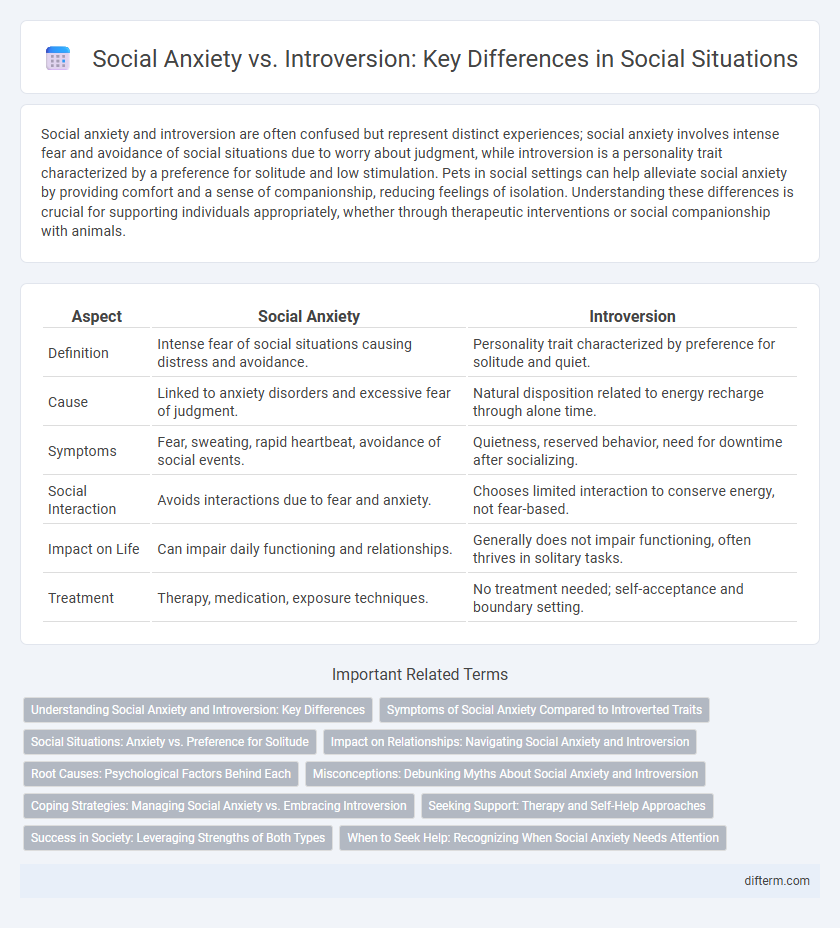Social anxiety and introversion are often confused but represent distinct experiences; social anxiety involves intense fear and avoidance of social situations due to worry about judgment, while introversion is a personality trait characterized by a preference for solitude and low stimulation. Pets in social settings can help alleviate social anxiety by providing comfort and a sense of companionship, reducing feelings of isolation. Understanding these differences is crucial for supporting individuals appropriately, whether through therapeutic interventions or social companionship with animals.
Table of Comparison
| Aspect | Social Anxiety | Introversion |
|---|---|---|
| Definition | Intense fear of social situations causing distress and avoidance. | Personality trait characterized by preference for solitude and quiet. |
| Cause | Linked to anxiety disorders and excessive fear of judgment. | Natural disposition related to energy recharge through alone time. |
| Symptoms | Fear, sweating, rapid heartbeat, avoidance of social events. | Quietness, reserved behavior, need for downtime after socializing. |
| Social Interaction | Avoids interactions due to fear and anxiety. | Chooses limited interaction to conserve energy, not fear-based. |
| Impact on Life | Can impair daily functioning and relationships. | Generally does not impair functioning, often thrives in solitary tasks. |
| Treatment | Therapy, medication, exposure techniques. | No treatment needed; self-acceptance and boundary setting. |
Understanding Social Anxiety and Introversion: Key Differences
Social anxiety involves intense fear of social situations and concern about being negatively judged, leading to avoidance and significant distress, whereas introversion is a personality trait characterized by a preference for solitary activities and recharging alone without fear of social judgment. Individuals with social anxiety often experience physical symptoms like sweating and rapid heartbeat in social settings, unlike introverts who may simply feel drained by prolonged social interaction. Recognizing these key differences helps in tailoring effective coping strategies and support for those facing social anxiety versus embracing introverted tendencies.
Symptoms of Social Anxiety Compared to Introverted Traits
Social anxiety symptoms include intense fear of judgment, avoidance of social situations, and physical signs like sweating or trembling, while introverted traits involve a preference for solitude and deep thought without the fear-driven avoidance. Unlike introversion, social anxiety significantly impairs daily functioning and social interactions due to overwhelming nervousness and self-consciousness. Understanding these differences helps in identifying when professional support is needed, as social anxiety constitutes a mental health condition beyond mere personality traits.
Social Situations: Anxiety vs. Preference for Solitude
Social anxiety triggers intense fear and avoidance of social situations due to the anticipation of negative judgment, impairing daily functioning. Introversion reflects a preference for solitude and low social stimulation without associated fear or distress. Understanding this distinction helps tailor effective coping strategies for social engagement challenges.
Impact on Relationships: Navigating Social Anxiety and Introversion
Social anxiety often leads to intense fear of judgment and avoidance of social situations, significantly impacting relationship-building by creating barriers to open communication and trust. Introversion, characterized by a preference for solitude and low-stimulation environments, can limit social interactions but does not inherently cause distress or impair relationships. Effective navigation involves understanding these differences to foster empathy, creating supportive environments that accommodate both social anxiety and introverted preferences for healthier interpersonal connections.
Root Causes: Psychological Factors Behind Each
Social anxiety stems from intense fear of judgment or rejection, often rooted in past traumatic social experiences or genetic predispositions affecting amygdala activity and stress response. Introversion arises from inherent neurobiological traits linked to cortical arousal levels and dopamine sensitivity, leading to a preference for low-stimulation environments without underlying fear. Distinguishing these psychological factors clarifies why social anxiety involves debilitating avoidance, while introversion reflects a natural inclination for solitude and reflection.
Misconceptions: Debunking Myths About Social Anxiety and Introversion
Social anxiety is often mistaken for introversion, but they are distinct conditions, with social anxiety involving intense fear of social situations and introversion reflecting a preference for solitude. Many assume introverts are shy or anxious, yet introversion simply denotes energy recharge through alone time without the debilitating fear characteristic of social anxiety disorder. Clarifying these differences helps reduce stigma and promotes better support for individuals facing social anxiety versus those who are naturally introverted.
Coping Strategies: Managing Social Anxiety vs. Embracing Introversion
Managing social anxiety involves targeted coping strategies such as cognitive-behavioral techniques, mindfulness practices, and gradual exposure to social situations to reduce fear and build confidence. Embracing introversion centers on honoring personal boundaries, prioritizing solitude for recharging, and engaging in meaningful one-on-one interactions rather than large group settings. Differentiating these approaches allows individuals to tailor their social experiences effectively, promoting mental well-being and authentic self-expression.
Seeking Support: Therapy and Self-Help Approaches
Seeking support through cognitive-behavioral therapy (CBT) effectively reduces symptoms of social anxiety by addressing irrational fears and promoting coping strategies. Introverted individuals may benefit from self-help approaches such as mindfulness meditation and gradual exposure to social settings to enhance comfort without overwhelming their natural preference for solitude. Both therapy and self-help techniques empower individuals to manage social challenges and improve overall well-being.
Success in Society: Leveraging Strengths of Both Types
Success in society often depends on leveraging the unique strengths of both social anxiety and introversion. Individuals with social anxiety develop resilience and empathy through navigating discomfort, while introverts excel in deep focus and thoughtful communication. Combining these traits fosters authentic connections and effective collaboration, driving personal and professional growth.
When to Seek Help: Recognizing When Social Anxiety Needs Attention
Social anxiety becomes a concern when fear of social situations leads to avoidance that disrupts daily life, work, or relationships. Unlike introversion, which is a personality trait marked by a preference for solitude, social anxiety causes intense distress and physical symptoms such as sweating, trembling, or rapid heartbeat. Seeking professional help is crucial if these symptoms persist for weeks, interfere with functioning, or prevent participation in important social activities.
social anxiety vs introversion Infographic

 difterm.com
difterm.com